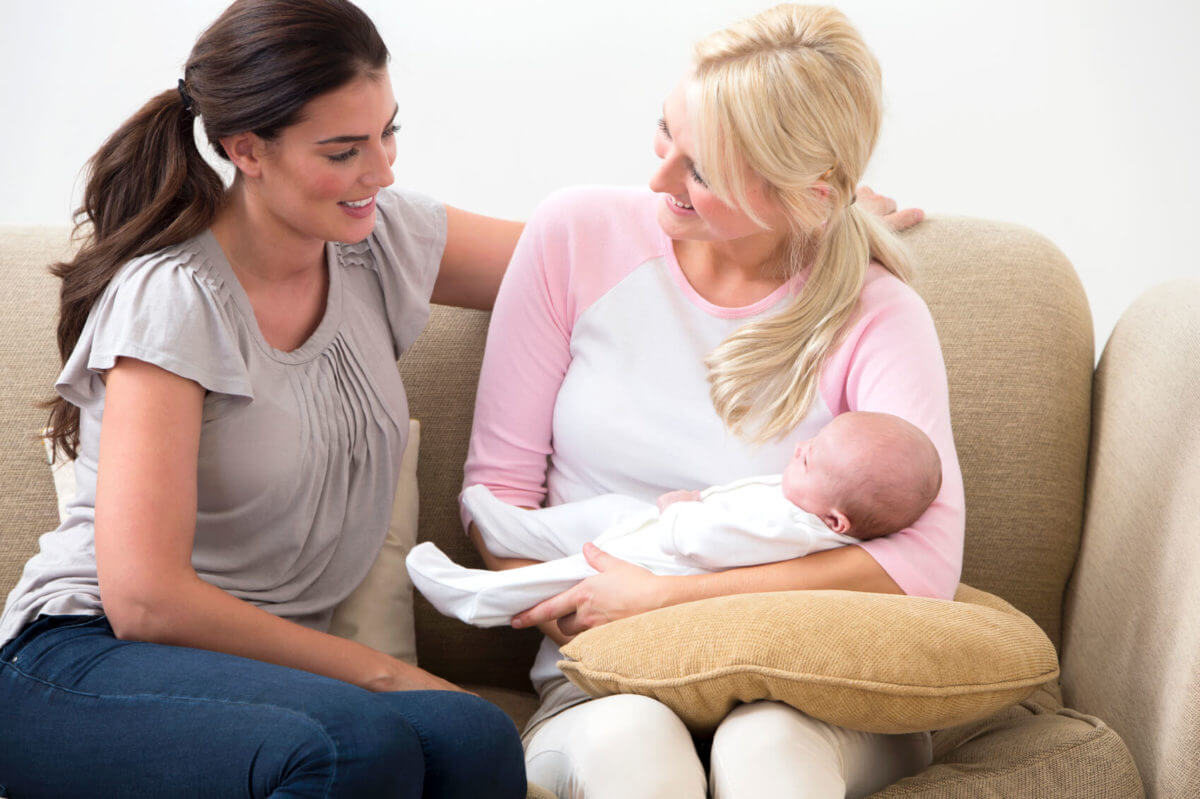You are considering the difficult yet selfless decision to place your child for adoption, and you need to decide which relationship to have with your child and the adoptive parents long-term: open, semi-open or closed. There is no right or wrong adoption relationship – the correct one is the relationship that works best for all parties involved, but especially for your child.
For generations closed adoptions were the norm, but in the late 1990s feelings about adoption shifted in favor of more semi-open adoptions. Today adoptive families are more open to communicating and interacting with birth mothers than ever before, which results in you receiving pictures and letters from the adoptive family to ensure you that your child is doing well. You are also able to send pictures and letters to the adoptive family, who will present them to your child at the appropriate age.
Because a certain degree of communication between parties is beneficial in most adoptions, many national adoption agencies prefer their families to be accepting of at least a semi-open relationship with the birth mother. Most adoptive families are excited about getting to know the birth mother and learning as much about you as possible so they can share your information with the child as he or she grows up.
However, there are circumstances where the birth mother feels more comfortable with a closed adoption, which of course can also be facilitated by the agency.
Your adoption professional will help you decide which adoption relationship matches the goals of your adoption plan and will help you find an adoptive family who is comfortable with the same level of contact that you are looking for. Whichever adoption relationship you choose, be sure to educate yourself about all of the factors associated with each type of adoption.
The following will help you get started in deciding which is preferable to you in your adoption plan:
Open Adoption
Some birth mothers choose an open adoption because they want to maintain personal contact with their child and the adoptive family. Open adoptions include pictures and letters, periodic telephone calls and even occasional visits, depending on what is desirable for all parties.
In an open adoption, some identifying information is exchanged between the birth mother and adoptive family. The adoptive family may then choose to send pictures and letters directly to the birth mother as opposed to having the agency facilitate the exchange.
Open adoptions can be beneficial for birth mothers and adoptive families who are comfortable with this kind of relationship. By communicating directly with each other, the relationship can develop more naturally than in other types of adoptions, but completely open adoptions are not for everyone.
These relationships are not as common as semi-open adoptions because often times it can be difficult for the birth mother to be in direct contact with the adoptive family and child. Personal contact with them can serve as a constant reminder of the difficult decision that the birth mother made and can make it more difficult for her to move forward and work through the grief and loss process associated with adoption. Birth mothers often think about their child and sometimes visits can start the grief and loss process over again.
Another difficult aspect of an open adoption is that although the birth mother can be an important figure in the child’s life, she doesn’t have any say in the decision making or parenting of the child.
For some birth mothers, however, having a more open adoption, including the occasional visits, is helpful. It is important for birth mothers to remember that all adoption relationships are flexible, and even choosing an open adoption doesn’t mean the birth mother must have or continue visits.
If you choose an open adoption, be sure to keep in contact with your adoption professional to let them know if anything about your open adoption changes. You have every right to feel the emotions you are feeling about your adoption plan and it is important to reach out to others when you need to talk.
Closed Adoption
Although semi-open adoptions have become the most popular type of adoption in the past decade, there are still birth mothers who find that closed adoptions match their adoption plan better than semi-open adoptions. Certain birth mothers choose closed adoptions because they feel that knowing certain information and receiving updated pictures and letters about the child will only make their decision more difficult and will not allow them to move forward after the finalization of the adoption.
Regardless of the type of adoption relationship they choose, birth mothers still have the option to select the adoptive couple with whom they want to place their baby. There are also birth mothers who would prefer that the agency choose the adoptive couple by considering the birth mother’s ideal characteristics of an adoptive family.
The decision whether or not to choose the adoptive family is yours, and all identifying information is kept confidential unless you choose to share it with the adoptive family at a later time.
Adoptive relationships are fluid and can increase in communication, just like any other relationship. If you decide at this point in your life that a closed adoption is healthiest for you and your child, you can always change your mind and request letters and pictures months or years after placement. This would be facilitated by your adoption professional who would then submit your request to the adoptive family. Adoptive families are typically open to sending pictures and letters, even if the parameters of a closed adoption are originally set.
Semi-Open Adoption
Today the majority of adoptions are semi-open, which simply means that the birth mother periodically receives pictures and letters from their child after placement has occurred. In these types of adoptions, contact between the birth mother and the adoptive family is mediated through the adoption agency. Many national agencies encourage semi-open adoptions, accounting for nearly 90 percent of their completed adoptions.
Pictures and letters are typically sent twice a year for the first five years and then once a year from ages 6 to 18 years old. Adoptive families are sometimes open to continue to send them twice a year for all 18 years. You are also able to send your own letters and pictures to your child and the adoptive family through the agency.
Limited identifying information is known about the two parties in a semi-open adoption. Birth mothers will know the adoptive family’s first names and state in which they live but usually no other information, unless the adoptive couple or birth mother chooses to disclose more information.
As your child grows older, he or she will naturally have questions about you. By having a semi-open or open adoption, the adoptive parents are able to answer at least some of your child’s questions and request additional information or further medical information about you or your family. You can also provide the adoptive family a birth mother scrapbook, which will help them tell your story and why you chose adoption for your child.
One of the final reasons semi-open adoptions are popular is because they allow for the greatest flexibility out of the three types of adoptions. A semi-open adoption may go extremely well for all parties, and like any other relationship, in time it may grow into a more open relationship, depending on the goals of your adoption plan.
Open Adoption Goals and Myths
Open and semi-open adoptions have become popular during the past two decades because their goals allow for continued contact between the birthmother and adoptive couple which can create reassurance to the birthmother that she made the right decision. These goals ensure that the child…
- experiences no lost relationships from the adoption.
- celebrates all of the people in his or her life.
- understands his or her family dynamics through truth and not fantasy.
Furthermore, there are myths associated with open and semi-open adoptions that research has found to be untrue. The Minnesota Texas Adoption Research Project was conducted to study open adoptions versus the other types of adoptions. Its results dispel some common misconceptions about open adoptions:
- Open adoptions do not result in children being confused about who their parents are. The research shows that children understand the roles of both the birthmother and adoptive parents.
- Birth mothers do not experience more grief and loss when choosing an open adoption. Actually, the latter is true as those who choose closed adoptions experience more problems dealing with grief and loss.
- The openness of the adoption does not negatively influence the adoptee’s self-esteem in any way.
***
Adoption is viewed as an act of love and selflessness, regardless of what type of relationship you decide is best for your adoption plan. Choosing to receive letters and pictures is a personal decision that is very beneficial to many birthmothers.
Letters and pictures are often very important for the birth mother, but they are sometimes just as important for the child because the child is reminded that his or her biological mother cares. Growing up, your child will know that you are interested in his or her life and that the vision you had hoped for indeed came true.
Birth mothers who choose not to send and receive pictures and letters do not love their child any less than a birth mother who chooses to receive correspondence. You have to make a decision that you will feel comfortable with in the future.
If your goal is to stay updated on your child’s life or to even reunite with your child one day, then the decision of which adoption relationship to choose is obvious. However, no two situations are alike, so it is important for you to choose the type of adoption that presents the best life for your child and yourself. This decision can be difficult to make during pregnancy, so be sure to discuss the different types of adoption with your adoption professional as they will help you make a decision you are comfortable with.
To learn more about the different types of adoption and what they could look like for you, please don’t hesitate to contact us. In the meantime, you can begin looking through adoptive profile families here.







